





Disclaimer: Copyright infringement not intended.
Context
About Tungabhadra River
About Tungabhadra Dam
Importance
|
PRACTICE QUESTION Who among the following rulers of the Vijayanagar Empire constructed a large dam across the Tungabhadra River and a canal-cum-aqueduct several kilometers long from the river to the capital city?
Answer: A |






© 2025 iasgyan. All right reserved